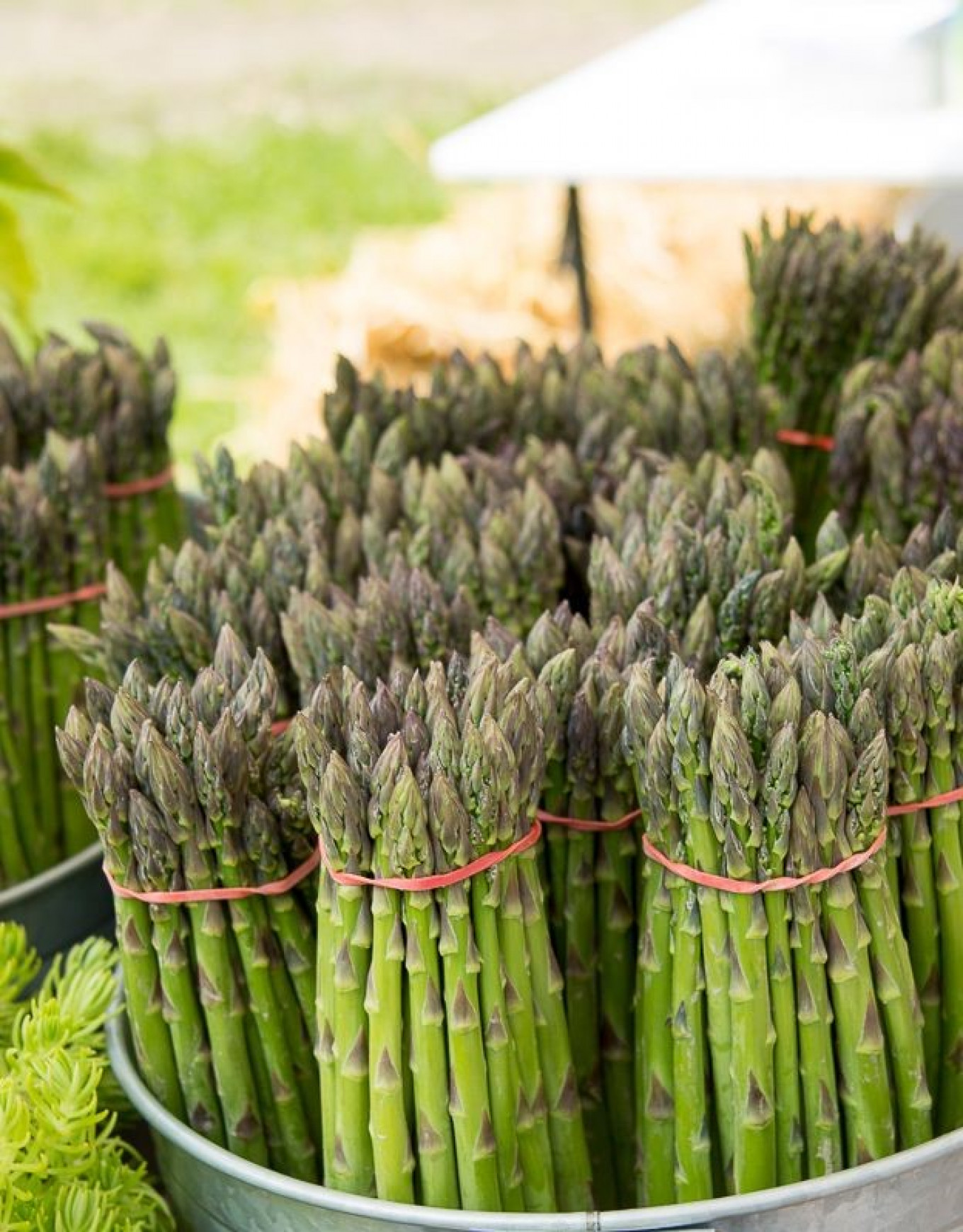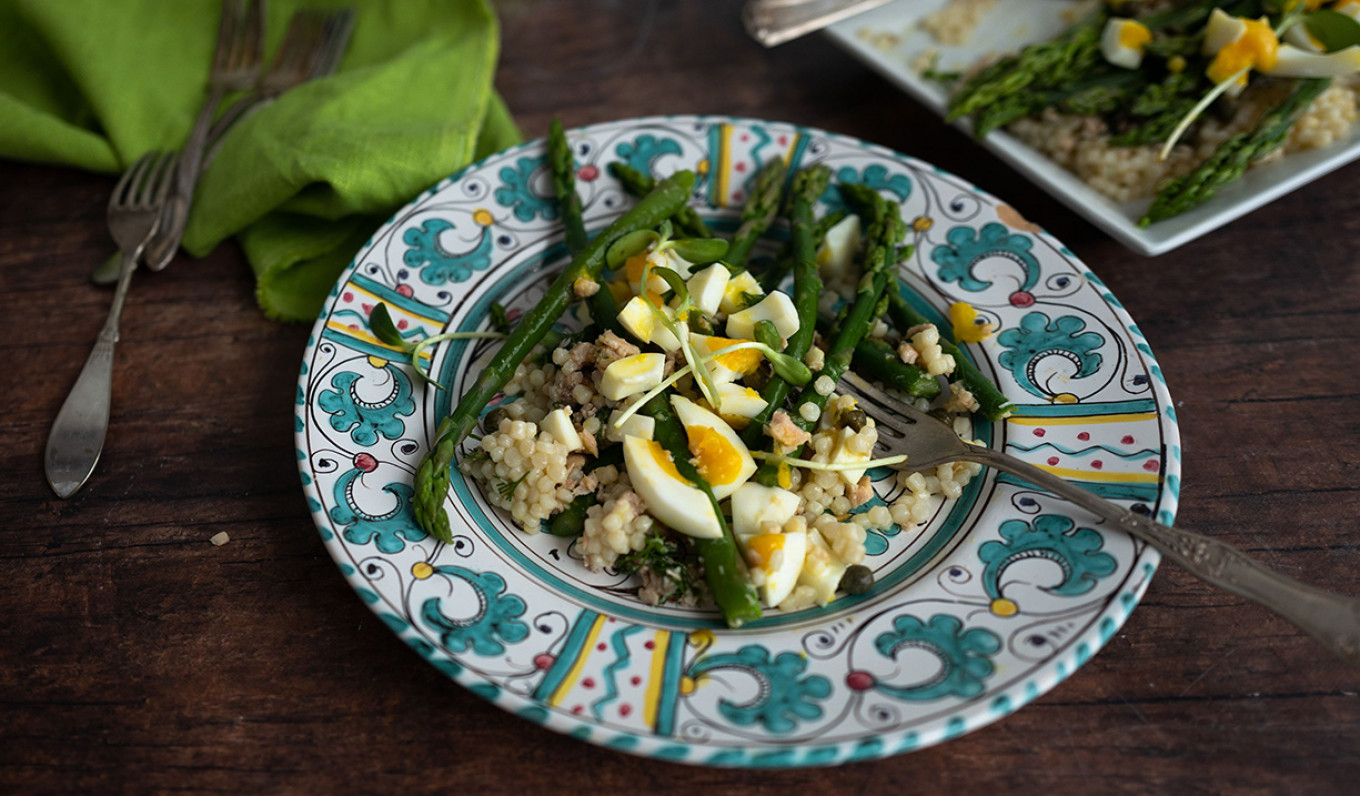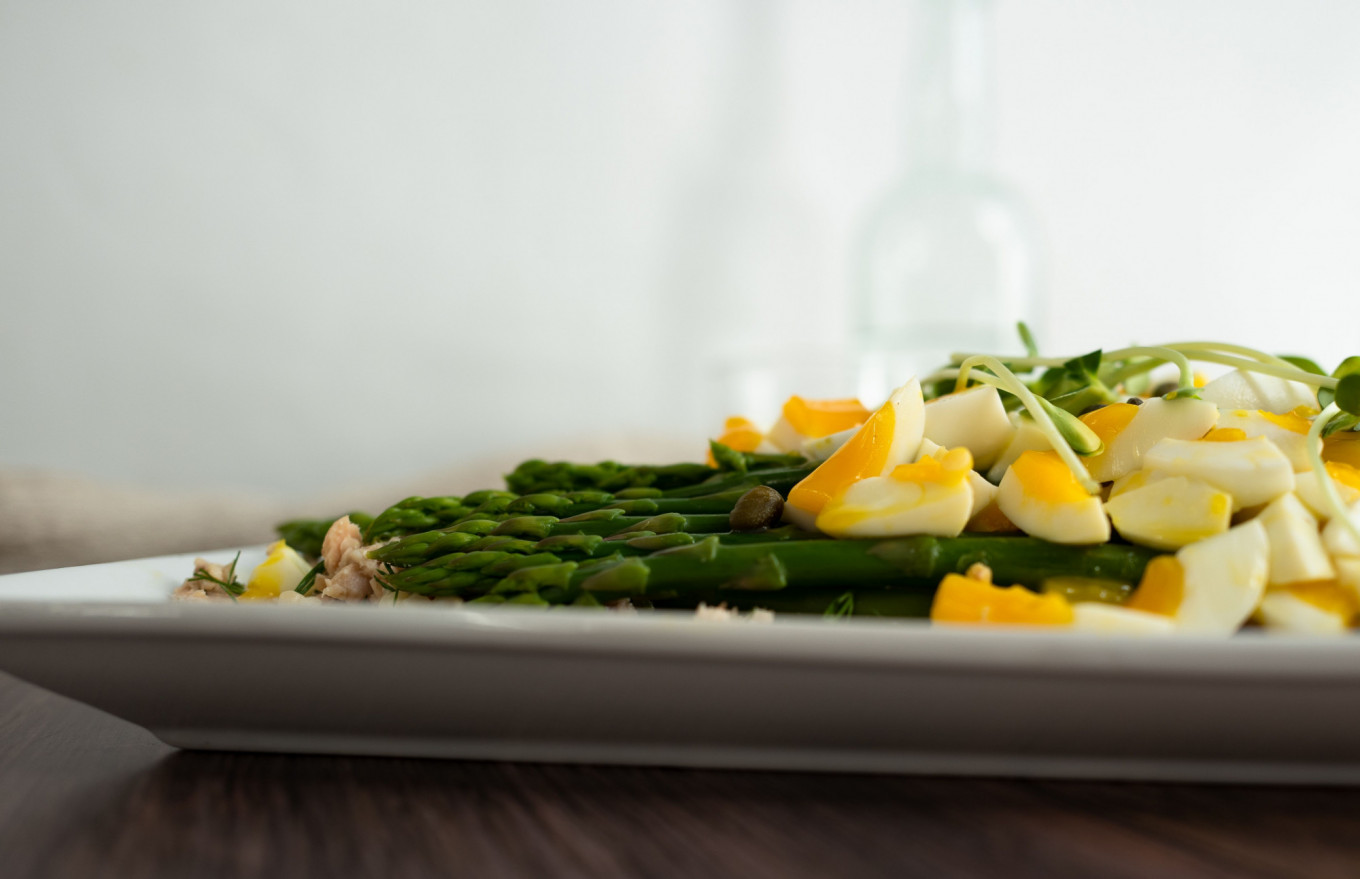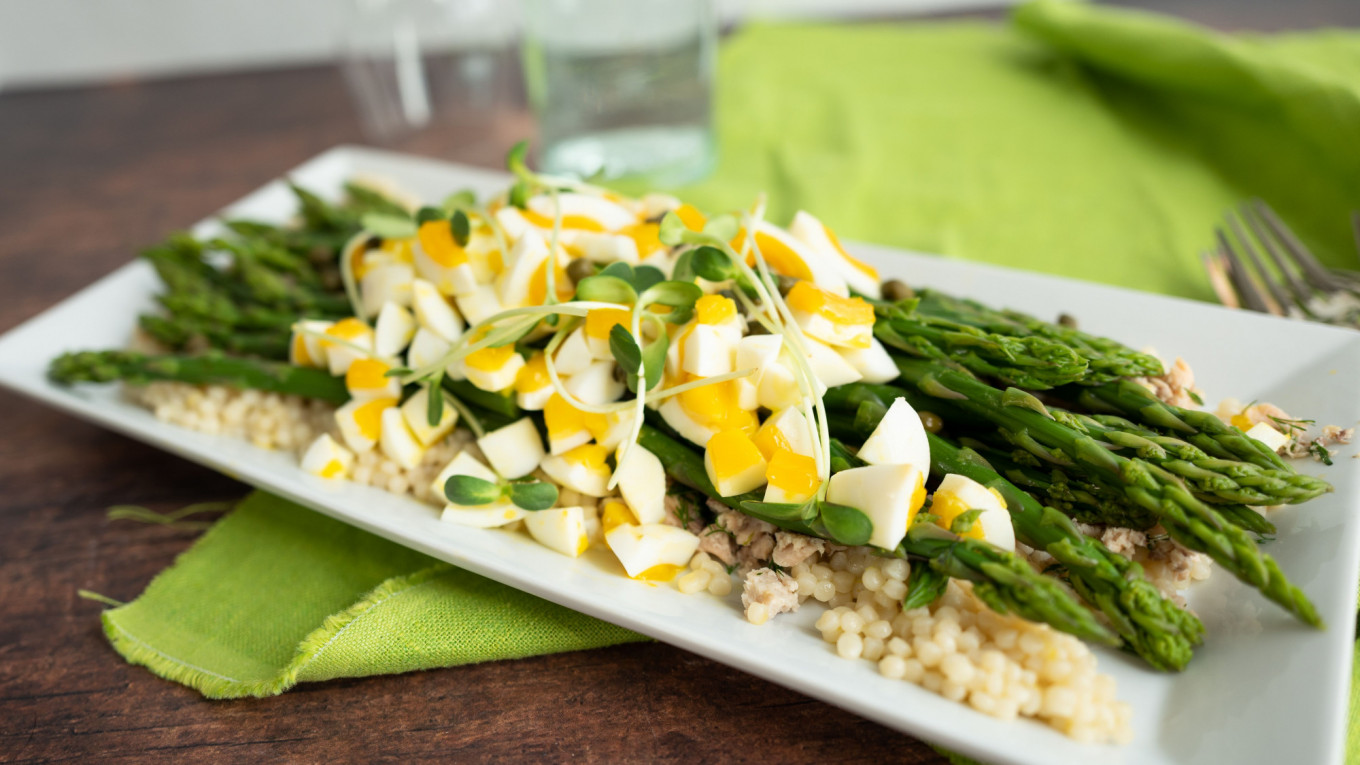We are entering what I think of as “sprint season,” and very welcome it is too. I’m not referring to any kind of physical exertion — unless of course you consider bounding across the market to snap up the last bunch of ramps — but, rather, that happy season of the year when some of the more delectable foods take center stage for their all-too-short period of peak perfection. Addictive ramps, pungent wild garlic, tangy cherries, and velvety ripe apricots each in their turn come into season and entice us into a bacchanalia of binge eating. In my family, a kilo of cherries or two punnets of early strawberries often makes up an entire meal in mid-May.
We are (finally) swinging into asparagus season, which I always regard as Mother Nature’s confirmation that winter is truly vanquished. There is something so robustly optimistic and congenially collegial about the deliberate upward thrust of a bunch of asparagus. Perhaps it is these qualities that make asparagus so irresistible; can I acquire these desirable traits if I consume enough asparagus?

Everyone has firm opinions about how asparagus tastes best. An ex-boyfriend of mine who lived in a major hub of the asparagus world swore by a liberal grating of fresh nutmeg and light shavings of parmesan. A chef I admire slices the spears thinly on the bias and stir-fries them with skirt steak and soy sauce, while another wraps individual spears in thin strips of Parma ham and puff pastry and bakes them in a hot oven. Each method is marvelous, but for my money, asparagus’s dusky meaty flavors are best paired with eggs (which are also a potent symbol of spring).
In this week’s recipe, we’re adding fish to the asparagus and egg fusion. Foodie internet has been ablaze lately with articles toting the merits of (admittedly upscale) tinned fish, confirming what long-term residents of the world’s largest country have always known: if you have a tin of fish, you have a meal. Or at least a salad, which in spring amounts to the same thing. My larder boasts a burgeoning selection of tins: sardines or anchovies in oil, smoked trout, mackerel, herring, shrimp, mussels, and even a few pedestrian cans of tuna. And this was the case pre-pandemic. I like to know that a healthy and satisfying lunch of tinned fish on toast or a quickly assembled dinner of pasta tossed with smoked mussels is only a few minutes away. So, it seemed time to add a modest contribution to the tinned fish plaudits.
Tinned fish is an anchor ingredient in a recipe I’ve been itching to tackle: salad mimosa. Salad mimosa is the third member of the Russian “potato salad family,” which includes shuba (herring under a fur coat) and salad Olivier. Mimosa is sort of Thebes to the others’ Athens and Sparta: the under-appreciated, often forgotten, less renowned (or notorious depending on how you feel) salad of the trio. This may stem from the fact that salad mimosa is not tied to a major holiday in the way that shuba and Olivier are tethered to New Year’s Eve. Salad mimosa has a loose association with International Women’s Day, but only because mimosa flowers bloom in early spring and are the symbol of March 8th.

Any dish can become "mimosa” if you garnish it with chopped or grated egg yolk in imitation of the mimosa flower. Classic salad mimosa is often made less appealing by dry and chalky egg yolks that have been cooked too long. Usually stacked or layered in a decorative glass dish, salad mimosa’s component parts are potatoes, some kind of colorful vegetable, usually carrot, tinned or smoked fish, and a final top layer of egg whites topped with grated egg yolk. In the finest Russian tradition, all of these layers are puttied together with generous helpings of mayonnaise. These are essentially the same ingredients found in Olivier, but somehow mimosa, like asparagus, seems more cheerful, celebratory, and far easier to associate with warmer weather than the other two.
When reinterpreting this kind of Russian classic, my usual approach is to deconstruct the salad, but in this case, the heavy potatoes simply refused to play second fiddle to the asparagus. So I jettisoned them in favor of one of my favorite starches: Israeli couscous. These nutty, pearl-like balls successfully masquerade as grains, but they are actually toasted pasta, with pasta’s admirable ability to absorb enough sauce to pull an entire dish together. This time of year, I turn to Israeli couscous again and again to bulk up summer salads, to stretch a vegetable soup, or to provide a light accompaniment to poached fish or grilled meat. They did not let me down in this new iteration of salad mimosa, providing a nice textural foil to the asparagus and good neutral base for the strong flavor of the tinned smoked salmon. If you wish, substitute any short pasta such as penne or even a grain such as quinoa or rice.
The eggs in this dish are that happy compromise between soft boiled and hard-boiled known as “jammy.” They are the perfect consistency for this dish — a celebration of warm weather, asparagus, the virtues of tinned fish, or anything else that makes you feel optimistic and hopeful. It’s that time of year.

Asparagus Mimosa
Ingredients
- ⅔ cup (156 ml) Israeli couscous
- Juice and zest of one lemon
- ½ cup (120 ml) olive oil
- 1 tsp Dijon mustard
- ½ tsp anchovy paste (optional)
- 2 ½ tsp salt
- Freshly ground black pepper
- One 1-lb (500 grams) bunch of asparagus
- 4 eggs
- One 4-oz (111 grams) tin of smoked fish (salmon, shrimp, and mackerel work well for this recipe)
- 2 Tbsp fresh dill, chopped
- 2 Tbsp capers, roughly chopped
- Fresh ground black pepper
Instructions
- Rinse the Israeli couscous under cool running water, then place it in a saucepan with 1½ cups water and 1 teaspoon salt. Bring to a gentle simmer, then cover and simmer on low heat for about 10-13 minutes until the pearls are no longer chewy.
- While the couscous is cooking, whisk together the lemon zest, juice, salt, mustard and anchovy paste, then slowly drizzle in the olive oil until combined. Add several grinds of the pepper mill.
- When the couscous has cooked completely, drain it, rinse it very briefly with cold water, then immediately return the couscous to the pot. Decant 3 tablespoons of the dressing and set aside, then add the remaining dressing to the couscous and toss to combine. Set aside for 15-20 minutes to allow the couscous to come to room temperature and absorb the dressing.
- Prepare the asparagus by snapping off the woody bottoms of the stems.
- Bring a pot large enough to hold the asparagus to a rolling boil and add 2 tablespoons of salt. As the water is heating, fill a large bowl with ice water and set aside.
- Carefully lower the eggs into the boiling water and let them cook for 6 minutes then immediately remove them from the pot with tongs (don’t discard the boiling water!) Immerse the eggs in the ice water for 2-3 minutes until they are cool enough to handle. (Note that the eggs are “jammy” — so for best results, hold off peeling them until the very last minutes before serving. If you prefer them firmer, add a few minutes to the cooking time.) Do not discard the ice water.
- Blanch the asparagus stems in the boiling water for 2-3 minutes depending on size, then plunge them into the ice water.
- Fork the couscous to fluff it, then spread it on a serving platter. Drain the tinned fish of most of its liquid, then use a fork to flake the fish over the couscous. Scatter the chopped dill and capers over the fish. Arrange the asparagus spears over the fish, spoon the 3 tablespoons of reserved dressing over the asparagus, then top with the chopped jammy eggs. Garnish with more dill and capers if desired. Serve immediately.

A Message from The Moscow Times:
Dear readers,
We are facing unprecedented challenges. Russia's Prosecutor General's Office has designated The Moscow Times as an "undesirable" organization, criminalizing our work and putting our staff at risk of prosecution. This follows our earlier unjust labeling as a "foreign agent."
These actions are direct attempts to silence independent journalism in Russia. The authorities claim our work "discredits the decisions of the Russian leadership." We see things differently: we strive to provide accurate, unbiased reporting on Russia.
We, the journalists of The Moscow Times, refuse to be silenced. But to continue our work, we need your help.
Your support, no matter how small, makes a world of difference. If you can, please support us monthly starting from just $2. It's quick to set up, and every contribution makes a significant impact.
By supporting The Moscow Times, you're defending open, independent journalism in the face of repression. Thank you for standing with us.
Remind me later.







